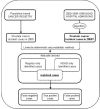Is hospital discharge administrative data an appropriate source of information for cancer registries purposes? Some insights from four Spanish registries
- PMID: 20059773
- PMCID: PMC2836319
- DOI: 10.1186/1472-6963-10-9
Is hospital discharge administrative data an appropriate source of information for cancer registries purposes? Some insights from four Spanish registries
Abstract
Background: The use of hospital discharge administrative data (HDAD) has been recommended for automating, improving, even substituting, population-based cancer registries. The frequency of false positive and false negative cases recommends local validation.
Methods: The aim of this study was to detect newly diagnosed, false positive and false negative cases of cancer from hospital discharge claims, using four Spanish population-based cancer registries as the gold standard. Prostate cancer was used as a case study.
Results: A total of 2286 incident cases of prostate cancer registered in 2000 were used for validation. In the most sensitive algorithm (that using five diagnostic codes), estimates for Sensitivity ranged from 14.5% (CI95% 10.3-19.6) to 45.7% (CI95% 41.4-50.1). In the most predictive algorithm (that using five diagnostic and five surgical codes) Positive Predictive Value estimates ranged from 55.9% (CI95% 42.4-68.8) to 74.3% (CI95% 67.0-80.6). The most frequent reason for false positive cases was the number of prevalent cases inadequately considered as newly diagnosed cancers, ranging from 61.1% to 82.3% of false positive cases. The most frequent reason for false negative cases was related to the number of cases not attended in hospital settings. In this case, figures ranged from 34.4% to 69.7% of false negative cases, in the most predictive algorithm.
Conclusions: HDAD might be a helpful tool for cancer registries to reach their goals. The findings suggest that, for automating cancer registries, algorithms combining diagnoses and procedures are the best option. However, for cancer surveillance purposes, in those cancers like prostate cancer in which care is not only hospital-based, combining inpatient and outpatient information will be required.
Figures
References
-
- Black RJ, Simonato L, Storm HH, Demaret E. Automated data collection in cancer registration. IARC Technical reports. 1998.
-
- Tagliablue G, Maghini A, Fabiano S, Tittarelli A, Frassoldi E, Costa E, Nobile S, Codazzi T, Crosignani P, Tessandori R, Contiero P. Consistency and accuracy of diagnostic cancer codes generated by automated registration: comparison with manual registration. Population Health Metrics. 2006;4:10. doi: 10.1186/1478-7954-4-10. - DOI - PMC - PubMed


